Pekka Buttler, February 2021 – June 2022
With JAPB not aiming to cater for the TL;DR crowd, also this comparison/review article is on the long side. In order to keep loading times decent, the comparison has been divided into a number of sub-pages. If you already know what part of the comparison you want to focus on, use the table of contents below to jump to your point of interest.
This is Batch I of JAPB’s comparison of fast fifties. Have a look also at the ‘cover page’ of the entire fifties -comparisons here.
Table of contents
• Part 1: Introduction, the lenses: pedigree and handling (you are here)
• The lenses – selection criteria
• Lens characteristics and handling
• Canon FD 50 mm f/1.4 ‘chrome nose’
• Canon FDn 50 mm f/1.4
• Carl Zeiss Jena Prakticar 50 mm f/1.4
• Carl Zeiss Planar 50 mm f/1.4 (C/Y)
• Konica Hexanon AR 50 mm f/1.4
• Minolta Auto Rokkor-PF 58 mm f/1.4
• Minolta MC Rokkor-PG 50 mm f/1.4
• (SMC) Pentax-M 50 mm f/1.4
• Revuenon MC 50 mm f/1.4
• Lens Characteristics and Handling – Summary
• Part 2: IQ-comparison I – The Brick wall test
• Part 3: IQ comparison II – Urban vistas
• Part 4: IQ-comparison III – Bokeh and blur
• Part 5: IQ-comparison IV – Night-time vistas
• Part 6: Summary and conclusions
The lenses – selection criteria
The selection criteria for this comparison are easy: We’re looking at lenses in the 50–58 mm focal length bracket, that have an f/1.4 maximum aperture. As I have more of these lenses than I can comfortably schlepp around (or cover in one article), the lenses have been divided in batches. The batches themselves have been formed based on lens mounts (minimizing the number of adapters needed). Therefore, the lenses in this batch are:
• Canon FD 50 mm f/1.4 ‘Chrome Nose’ (FD -mount)
• Canon FDn 50 mm f/1.4 (FDn -mount)
• Carl Zeiss Planar 50 mm f/1.4 (C/Y -mount)
• Carl Zeiss Jena Prakticar 50 mm f/1.4 (Praktica B -mount)
• Konica Hexanon AR 50 mm f/1.4 (Konica AR -mount)
• Minolta Auto-Rokkor PF 58 mm f/1.4 (Minolta SR -mount)
• Minolta MC Rokkor-PG 50 mm f/1.4 (Minolta SR -mount)
• Pentax-M (SMC) 50 mm f/1.4 (Pentax K -mount)
• Revuenon (Auto) MC 50 mm f/1.4 (Pentax K -mount)
As always, I’m working with lenses I have on hand. Hence, this comparison is neither complete, nor do I manage to compare all the interesting alternatives. Even so, I hope it will prove both enlightening and useful.
Next we’re going to have a brief look into these lenses in slightly more detail.
Lens characteristics and handling
Canon FD 50 mm f/1.4 ‘chrome nose’ [data sheet] and Canon FDn 50 mm f/1.4 [data sheet]
The Canon FD 50 mm f/1.4 (chrome nose version) was introduced in March of 1971, along with the new FD-mount, the Canon F-1 and FTb bodies (and 13 other lenses). The FD-mount (and F- and A- lines of camera bodies were highly successful and cemented Canon’s role as a major player.
What is relevant for this comparison is, that Canon’s success was not based just on milking the cow. Instead, Canon continuously modified the existing lens designs, leading to that many Canon lenses have numerous iterations throughout the FD/FDn -era. The following table is based on data from The Canon Camera museum (which is not always totally accurate, but manages to cover the high points).
| V.# | Family | Introduced | Design | Min. f/ | MFD | Weight | Filter | Notable |
| 0 | FL | May 1968 | 7e/6g/8b | 16 | 0,6 | 340 | 58 | FL lens |
| 1 | FD | March 1971 | 7e/6g/8b | 16 | 0,45 | 370 | 55 | ‘chrome nose’ |
| 2 | FD | March 1973 | 7e/6g/8b | 16 | 0,45 | 350 | 55 | ‘S.S.C’ |
| 3 | FD | June 1973 | 7e/6g/8b | 16 | 0,45 | 305 | 55 | ‘S.S.C’ |
| 4 | FDn | June 1979 | 7e/6g/8b | 22 | 0,45 | 235 | 52 | all-black |
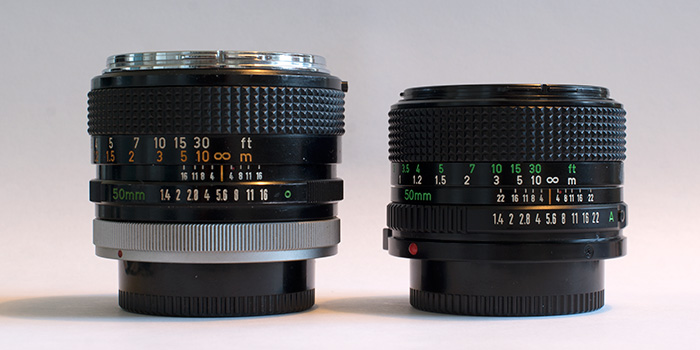
Left: Canon FD 50 mm f/1.4 ‘chrome nose’
Right Canon FDn 50 mm f/1.4
As can be seen from the table above, the basic optical design (elements and groups) remained stable over a period of several decades (technically, even the Canon EF 50/1.4 USM introduced 1993, and still being sold, is a direct descendant of the 1968 FL lens). On the other hand, lens coatings progressed and Canon is known to even have upgraded coatings without otherwise changing a lens’ design. But the most striking development is that of size and weight: from a diameter of 58 mm down to 52mm and from a maximum of 370 grams down to 235 grams. This weight-shaving was accomplished partially through successive redesigning of the lens housing, but also through a shift towards lighter materials: plastic instead of steel; aluminium instead of brass. While it is customary for legacy lens lovers to decry this shift towards lighter construction, lightness does have indisputable advantages.
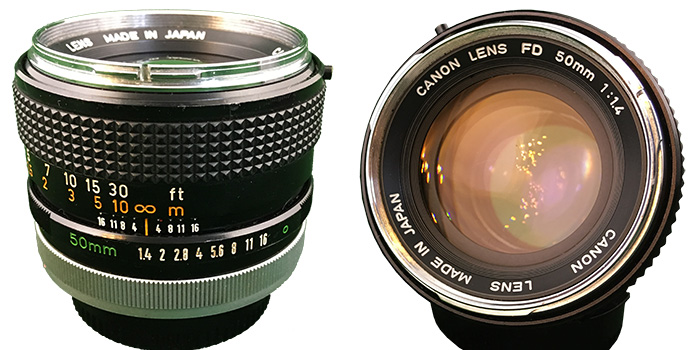
The tested ‘Chrome Nose’ sample (#232533) was manufactured in December of 1972, and – while it in terms of the FD lineage is an older lens – is among the last chrome nose lenses manufactured. Its weight (368 grams, measured) and other metrics are in line with data from the Canon Camera Museum. The tested sample is in mint condition.
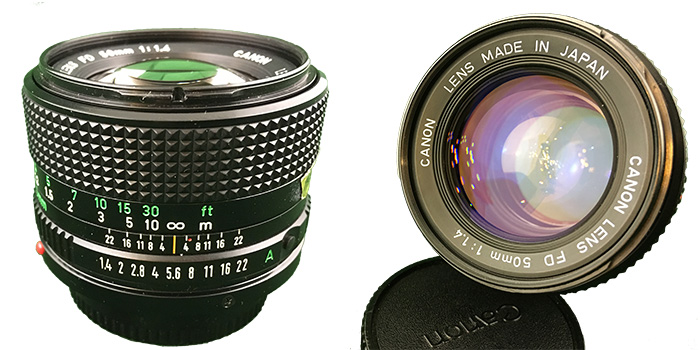
The tested FDn sample (#1501192) was manufactured March 1980, and comes with all the bells and whistles of a highly polished (and weight-shaved) last generation product. Also its specifications are in line with those mentioned in the table above. While it is in otherwise mint condition, it does suffer from a malaise relatively typical for FDn -lenses: its aperture ring has become slightly heavy-moving.
Handling-wise, these two lenses have very little in common, except that both sport a bayonet attachment for a lens hood.
The Chrome Nose version not only is heavy, it also feels heavily solid. There is no play anywhere, and the build quality has stood up to the test of time very well. Its focus ring movement feels substantial, and while it’s rubber could be a bit more grippy, the focus ring action is pleasing. The aperture ring feels tactile and solid. Alike all cameras geared towards shutter priority auto exposure it offers an extra setting for camera-controlled aperture, but unlike some (e.g. the Konica), you can exit the auto setting just as easily as you entered it. Problematically, FD lenses of this era (when used adapted) have what I call the four-ring-problem (see more here).
In contrast, the FDn version feels almost flimsy. While the FDn is only marginally lighter that the second-lightest lens in this comparison (the Pentax), it is somewhat larger and feels – in every way – less dense. While the FDn’s focus ring is slightly broader than that of its older sibling, the material feels plasticky (not rubbery), resulting in a focus ring that you need to grip quite tightly. The aperture ring is similarly plasticky, the grip-ridges are not very easy to grip, and the aperture ring’s motion offers significant resistance. Whether this is by design (as camera controlled apertures had pretty much become the norm by then) or due to age I cannot say (but the issue seems typical for FDn lenses). Canon also changed the Auto-aperture mode so that you have to press a button on the aperture ring to enter and exit auto aperture mode. Finally, thanks to the reworked mounting mechanism (bayonet instead of breech-lock), the four-ring problem is no-longer a real issue.
Read more (elsewhere):
Canon Camera museum
Carl Zeiss Jena Prakticar 50 mm f/1.4 (Praktica B) [data sheet]
While German optical companies were the first to manufacture really fast normal lenses (by which I here mean anything beyond f/1.8), such as the 1932 Zeiss Sonnar 50/1.5 [data sheet], for a long time such lenses were not possible for SLR cameras, because SLR cameras – due to their mirror box – required a significant back focus distance. Therefore, the f/1.4 normal lens (the topic of this comparison) became available only in the last seconds of the 1950’s and it took another couple of years for it to become commonplace.
At this time, technology leadership had clearly shifted to the land of the rising sun, and although Zeiss introduced their Planar 55/1.4 for the Contarex in 1961, Japanese camera companies practically swamped the markets (both in breadth of the offering as well as in numbers produced). While the West German optics industry managed to stay in the game (at least on paper), Japan had become the ruling force in the market for fast SLR glass.
At the same time, Dresden (the cradle of the German optics industry, now on the other side of the iron curtain) remained stuck with producing relatively slower designs: While Carl Zeiss Jena introduced the Pancolar 55/1.4 in 8/1963, only a couple of thousand were ever made. After that batch, users of East German optics had to make do with f/1.8 normal lenses, even though the faster f/1.4 lenses had become ‘de rigeur‘ for anyone wanting to sport fast glass. Hence, the world had to wait into the late 70’s for another East German f/1.4 normal lens to enter the scene: The Carl Zeiss Jena Prakticar 50/1.4.
The 50 mm f/1.4 Prakticar was offered only with the new Praktica bayonet mount, for use with Pentacon’s newer breed of Praktica B cameras. The lens was produced in two, easily distinguishable variants: to know whether your lens is of the older (1978-1982) type or the newer (1982 onward) you can either look for where the lens name is printed (outside the filter thread on the older model, inside on the newer), or use a Geiger-counter (the older design uses thoriated glass, the newer does not)1. An M42-mounted version was considered, but seemingly never progressed beyond a prototype batch.
By this time however, the East German camera industry had pretty much given up trying to entice the pros. As a result, sales of East German fifties gravitated towards the less bright (cheaper) end of the market. While production of the 50 mm f/1.4 Prakticar far outstripped that of its ancestor (the 55 f/1.4 Pancolar), it never became a really big seller. In the end, the Prakticar 50mm f/1.4 went the same way as the entire East German camera industry (When the Berlin wall crumbled, so did the camera industry).
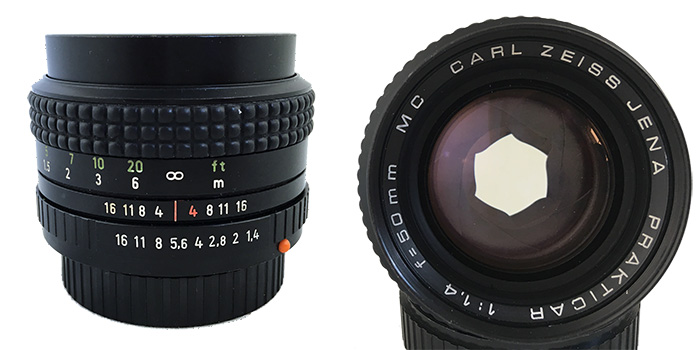
Left: side-on view focused to infinity
Right: front-facing view with signature aperture pattern
The tested sample (#13298) comes from the later series. While late-era East German lenses are often known for feeling cheap and not having the build quality of major-brand Japanese offerings, this lens clearly has been intended to be a quality product: there is absolutely no play anywhere. The lens feels like a solid chunk of optical engineering. The rubberized focus ring is soft and grippy, and the aperture ring – while not quite on par with the best Japan had to offer (e.g. early Takumars) – offers a positive tactile experience. Even the stops and numbers line up perfectly (something not all Prakticar lenses managed).
Interestingly, the aperture blades do not even try to aim for a rounded shape stopped down: From f/2.8 to f/5.6 you have a pattern looking like the dreaded ‘Ninja star’, except on steroids, whereas after f/5.6 the pattern morphs into a somewhat swirly six-pointed star. We’ll see how this effects the lens’ out-of-focus areas and sunstars…
Read more (elsewhere):
• Development of the Prakticar 50 f/1.4 on zeissikonveb.de (in German)
• Review of the earlier version on vintage-camera-lenses.com
• Review of the later version on radojuva.com
Carl Zeiss Planar 50 mm f/1.4 (C/Y-mount) [data sheet]
One could summarise the whole era of legacy lenses for 36x24mm film by saying that there were
• Lenses manufactured by top-tier camera manufacturers (Canon, Leica, Konica, Minolta, Nikon, Olympus, Pentacon, Pentax etc.),
• Lenses manufactured by those camera companies that – while moderately successful – never made it into the top-tier (Cosina, Chinon, Ricoh etc.),
• Lenses manufactured by companies that either focused purely on lenses (Carl Zeiss Jena, Meyer-Optik, Schneider, Sigma, Tamron) or made an interchangeable lens camera more as an experiment or as an afterthought .
But as with any summarisation – the point of which is to enfold a rule, major trend, or relationship by sacrificing detail – it always has exceptions.
Carl Zeiss (West/Oberkochen) is not the only company to defy this classification, but it is one of the most prominent. Not only did Zeiss (through Zeiss Ikon) have an investment in cameras (a business they let go in the 70’s), they also collaborated repeatedly with other camera manufacturers (e.g. Hasselblad, Rollei, Yashica) in order to secure a market for their lenses (not to mention the Zeiss Cine lenses). One day Zeiss’ will surely deserve a JAPB article of its own, but for now, I’ll give you this short introduction into the Zeiss hall of legends.
Within the Zeiss-Yashica(Kyocera) collaboration, Zeiss offered two 50 mm focal length lenses, this f/1.4 lens, as well as the slightly slower f/1.7 version. Initially these lenses for the “Contax/Yashica” or C/Y mount were all geared towards aperture priority auto exposure (AE lenses), and were later updated to support other auto exposure modes (shutter priority, program) as well (MM/Multi-mode lenses). This lens (serial #6038002) is an early AE lens from 1977.
Only a few Zeiss C/Y -lenses were optically redesigned going from AE to MM, meaning that the optical recipe of this lens is the same as that of later samples. That said, three noteworthy changes were made to all lenses going from AE to MM: Firstly, the lens innards were updated to support multi-mode metering (i.e. body-controllable apertures); secondly, the shape of the aperture blades was changed; and finally, many lenses received a coating upgrade. That said, even earlier AE Zeiss lenses are usually considered to have very good coatings (for that era).
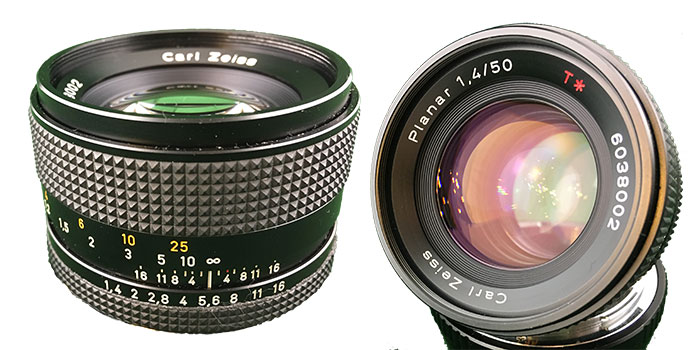
The tested sample is in very good condition and shows the quality workmanship of Zeiss manufacture (this lens was assembled in Japan, to Zeiss standards). Based on size and weight the lens is decidedly in the middle – not as light as the FDn, Pentax or Revuenon, not as heavy as the FD Chrome Nose or either Minolta.
That the handling and ergonomics are first-rate should also not come as a surprise. The aperture ring feels like a combination of smooth and chunky peanut butter (movement is smooth as silk, but the clicks are very satisfying), although I personally bemoan the lack of intermediate stops at the wider-open end. The focus ring is satisfyingly wide and very tactile. The rubber compound on both aperture and focus rings is soft and very grippy, which leads to them both having a tendency to gather dust and fibres. While the signature checkered pattern used by Zeiss C/Y lenses affords for a steady grip, I personally think it is visually a bit on the brutalistic side and If I’d have to choose one aesthetic element to change on the Zeiss, it would be the patterning of the rubber rings.
Read more (elsewhere):
• Detailed review of AE version by Casual Photophile
• Detailed review of AE version by Phillip Reeve
Konica Hexanon AR 50 mm f/1.4 (AR -mount)[data sheet]
Konica was the company that basically pioneered both fully coupled light metering and shutter priority auto-exposure. Besides that, Konica lenses were widely respected for their attention to optical craftsmanship. While Konica never managed the transition into auto focus SLR’s and while Konica’s lens portfolio never was as wide as those of its Japanese major competitors (Canon, Minolta, Nikon, Olympus, Pentax), there is no doubt about Konica’s merits in designing standard focal length (50-57) fast lenses.
After progressing from the (relatively) short-lived Konica F mount to the Konica AR mount, Konica produced two f/1.4 standard lenses. The Konica 57/1.4 was produced in 1965-1972 and went through four, mostly ergonomic iterations before being supplanted by the 50/1.4, which – with only three iterations – remained Konica’s standard fast standard lens from 1972 until Konica’s withdrawal from SLR manufacture in 1988. Of the three versions of the 50/1.4, the earlier’s two have a minimum aperture is f/16 (anda are known to use a thoriated element and thus be radioactive), and the later version’s minimum aperture is f/22 and is not radioactive.
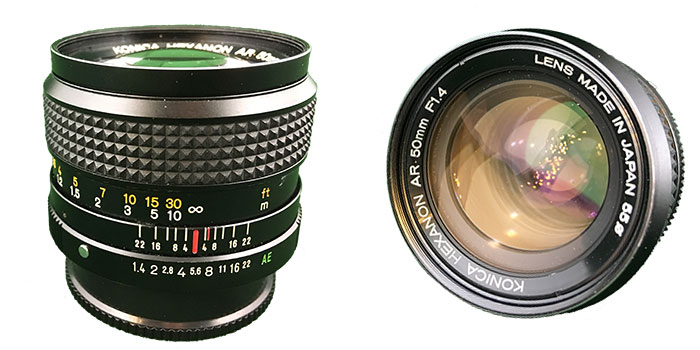
This lens (#7709091) has an aperture range spanning from f/1.4 all the way until f/22, and should therefore be one of the last iterations of Konica fast fifties. The sample in question is in mint condition.
In your hand it feels pleasingly solid and – for being a 1980’s lens – metallic. That said, the rubberised focusing ring is relatively narrow and could be more grippy, but my major gripe with this (as with all Konica AR lenses) is in the implementation of the aperture ring: Given Konica’s heavy investment in shutter priority auto exposure, Konica lenses’ apertures were typically not intended to be manipulated by the photographer (but by the camera). And this shows. Not only is the aperture ring quite raspy – one might want to move the aperture ring a notch but end up moving it several notches – it also has an AE/EE setting (for when the camera controls the aperture), that you can enter by accident, but cannot exit as simply. While I do like the optical character of Konica AR lenses, I do not think their tactile usability is at the same level.
Read more (elsewhere):
• Specs on buhla.de
• Details on konicafiles.com
Minolta Auto Rokkor-PF 58 mm f/1.4 [data sheet]
In some ways, this is an outlier in this test, being the only lens to have a (stated) focal length different from 50 mm. Also, the 58 mm Minolta is by some margin the oldest lens in this comparison.
The Minolta 58 mm f/1.4 lens was originally introduced in 1959 and stayed in production until being supplanted by the 50 mm f/1.4 lens in 1973. During that time, it went through four variations, with only the later two being MC -compatible (MC: Meter coupling). During these four variations the optical recipe (6 elements in 5 groups, 6 blades and an MFD of 0,6 meters) stayed unchanged, but the lens received some weight-shaving (going from 320 grams in the first variant to 275 grams in the last variant), and was updated (in 1966) to support meter coupling. As with many lenses that remained otherwise unchanged, one can expect coatings to have been upgraded towards the later specimen.
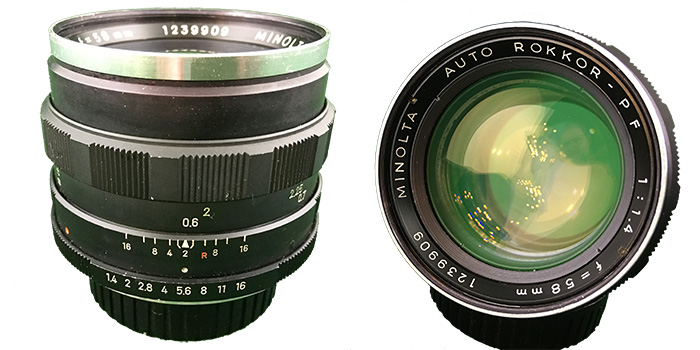
This sample (#1239909) is one of the earliest variants of the Minolta 58 mm f/1.4. At 322 grams (measured) it is a hefty chunk of optical engineering. Even so, it is not the heaviest lens in the comparison (that questionable honour goes to the ‘chrome nose’ Canon). The lens shows another couple signs of being a relatively early design. Firstly, its aperture’s blades (8 pcs) are silvery (unpainted). Furthermore the lens also has a separate lever for stopping down the lens (for DOF preview/metering), and therefore does not depend on the body for DOF preview. This functionality was subsequently dispensed with as Minolta bodies adopted wide-open metering.
The build quality of this lens is simply brilliant. The aperture ring moves nicely and satisfyingly. The click-stops are solid and nicely dampened, and you can feel the ball clicking into place. That said, I’d prefer the aperture ring to be a bit wider and have half-stop clicks. The milled metal focusing ring is very well dampened and while its resistance is a tad stronger than I’d prefer, its operation oozes quality.
n.B! and mea culpa. I have used this lens many times (mainly for portraiture and similar medium-distance photography), but had never noticed that this sample has a focus calibration issue (its infinity hard stop is at some tens of metres). As this became evident during analysing the comparison’s shots, I:
• tried to repair the lens only to notice that the calibration leeway was insufficient (it cannot have performed well even on leaving the factory) – a potential explanation for the lens’ mint condition
• procured another mint sample, only to find that that lens’ aperture mechanism from shoddy manufacturing.
• procured a third sample, only to find that it was severely de-centred.
As a result:
• I cannot but conclude that this lens does not have the best track record regarding reliablity and sample variation…
• I’ve included this lens in the comparison only inasmuch as its failings do not affect the imagery (no infinity or long-distance shots.
Read more (elsewhere):
• Minolta lens index (at minolta.easypix.de)
• Detailed review of a later MC 58 mm f/1.4
Minolta MC Rokkor-PG 50 mm f/1.4 [data sheet]
If the above Auto Rokkor was Minolta’s first stab at producing an f/1.4 SLR lens, then this – the MC Rokkor-PG 50 mm f/1.4 – is an altogether more mature affair. Minolta introduced the 50 mm f/1.4 lens in 1973, and manufactured altogether 5 variants of the lens – one MC (meter coupled) variant and four subsequent MD -compatible variants. Interestingly, there were substantial differences between 4 of these 5 variants (the first two MD variants introduced 1977 and 1978 were essentially the same, with only aesthetic differences), and to illustrate the developments without a table defies my powers of expression.
| Name | Min f/ | Design (e/g) | Filter | hood | MFD | Dimensions (diam. x length) | Weight | Introduced | MC/MD |
| MC Rokkor-PG | 16 | 7e/5g | 55 | screw-in | 0,5 m | 65 x 46 | 305 | 1973 | MC |
| MD Rokkor | 16 | 7e/5g | 55 | screw-in | 0,5 m | 64 x 40 | 245 | 1977 | MD |
| MD Rokkor | 16 | 7e/5g | 55 | screw-in | 0,5 m | 64 x 40 | 245 | 1978 | MD |
| MD Rokkor | 16 | 7e/6g | 49 | screw-in | 0,45 m | 64 x 40 | 220 | 1979 | MD |
| MD | 16 | 7e/6g | 49 | clip-on | 0,45 m | 64 x 40 | 235 | 1981 | MD |
Compared with the earlier 58 mm focal length versions, the new 50 mm f/1.4 lenses (all variants) used one more lens element and offered a shorter minimum focusing distance.
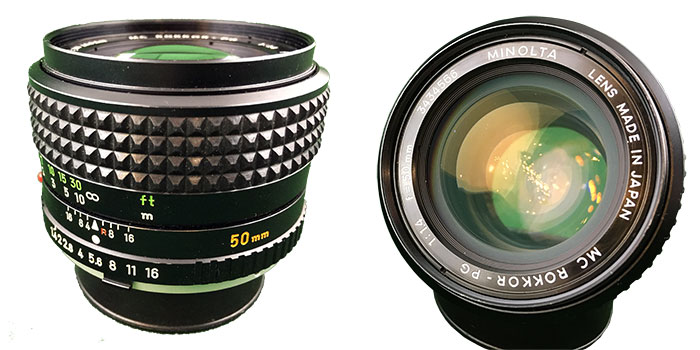
The tested sample (#3434566) is one from the earliest of the five variants, and can therefore not be expected to have the latest coatings. On the other hand, while the lens has a distinctly more modern look than that of its predecessor, it also still has the same solidity and hefty sort of build quality that screams ‘Metal!‘ at anyone who holds it in their hands. Build quality is A1+. Luckily my sample is also in totally mint condition.
If I had to judge this lens purely on its tactile qualities I would rate it as very good. It has a relatively broad rubberised focus ring that moves smoothly and satisfactorily. The focus throw at 170 degrees is the shortest in this comparison, but is more than sufficient for accurate manual focusing. The aperture ring has many of the same (good) qualities of its older brethren, and now adds half-stops, though oddly only from f/2 onward (huh?). The aperture blades (6 in total) are shaped in such a way as to produce a perfectly circular aperture at f/2 and, that morphs into a clearly defined hexagon at f/4. All in all, a promising-feeling package.
Read more (elsewhere):
• Detailed review of MC variant on phillipreeve.net
• Comparison of MC and early MD variants on rokkorfiles.com
Pentax-M (SMC) 50 mm f/1.4 (Pentax K) [data sheet]
The SMC Pentax-M 50 mm f/1.4 lens has an admirable pedigree. It is – as far as any lens can be seen to descend from another – direct progeny of the 50 mm f/1.4 Super/Super-Multi-Coated/SMC Takumar that – without doubt – can be seen as one of the most legendary large aperture lenses of all times. This lens, however is not the same lens (an SMC Takumar 50/1.4 will be reviewed at a later date).
Pentax (a.k.a. Asahi) was one of of the few major camera manufacturers that initially did not go for a proprietary lens mount. When Pentax changed course in 1975 and introduced the Pentax K mount, it resulted in a whole lineup of new lenses, many of which were significantly redesigned compared to their predecessors.
The SMC Pentax-M 50 mm f/1.4 was one of the new series of bayonet mount lenses, and was introduced in 1977. It was replaced by the Pentax-A 50 mm f/1.4 in 1984. Sadly, I have no information on whether the Pentax-M version stayed unchanged during the 7-year production run, or whether there were significant variations (if you know, drop me a line).
The Pentax-M 50 mm f/1.4 is a relatively customary late 70’s fast fifty: It is relatively small and light, its aperture closes down all the way to f/22. Furthermore, it’s based on (what by now had become the default recipe for a 50/1.4 lens) a 7 elements in 6 groups design, and uses an 8-blade aperture. The blades are somewhat rounded, but at f/2 they produce an aperture pattern reminiscent of a circular saw blade (a.k.a. ‘ninja star’).
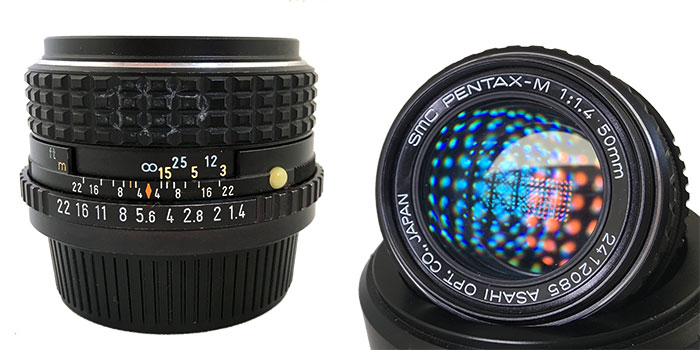
The tested sample (#2412085) is probably a relatively early (1970’s) sample, but is happily in perfect condition. In fact, the lens’ biggest blemish is due to an uncleanly removed ‘passed’ -sticker.
Personally, I find the lens to be slightly too small for comfort. When mounted on a modern full-frame dSLR (like the Pentax K-1), the body undoubtedly dwarfs the lens, whereas – when used adapted on a mirrorless camera, the lens is not a lot bigger than the adapter.
Luckily the ergonomics are as good as they can be in a package of this size (n.B! YMMV. My judgment is based on my relatively stubby fingers). While the aperture ring is narrow, it is nicely grippy, and quite tactile. The patterning of the focus ring is – while being quite pronounced – very grippy, even though the rubber compound is not especially soft. The Pentax-customary distance scale ‘window’ certainly is a bit divisive, but you get used to not being able to see the entire motion range of the focus ring at-a-glance.
Read more (elsewhere):
• User reviews at pentaxforums.com
Revuenon (Auto) MC 50 mm f/1.4 (Pentax K)
First, if you’ve never heard about Revuenon or Revue (in photo gear), don’t feel bad. Revue (cameras) and Revuenon (lenses) were in-house brands of Foto-Quelle – a German retailer of cameras and related equipment. During the late 60’s Foto Quelle was Europe’s largest photographic retailer – selling both major brand cameras as well as their in-house brands.
Revue SLR’s were typically rebranded Japanese, East-German and Soviet cameras, using a wide range of mounts. While the original models of various Revue-branded cameras are well known, the same can not be said of Revuenon lenses. Revuenon lenses are therefore something of a hit-and-miss game as the origin of the design and manufacture of a Revuenon branded lens cannot easily be ascertained. That said, given that some major brands (including Zeiss) sub-contracted some of their lens manufacture to many of these same manufacturers, a lens coming from outside the hallowed grounds of big-name camera manufacturers’ is not automatically a bad thing.
There is some confusion regarding the optical design of the Auto Revuenon MC. I’ve addressed this topic more thoroughly in the JAPB data sheet on the Revuenon MC 50/1.4, so I hope that you let your curiosity about arcane details loose there.
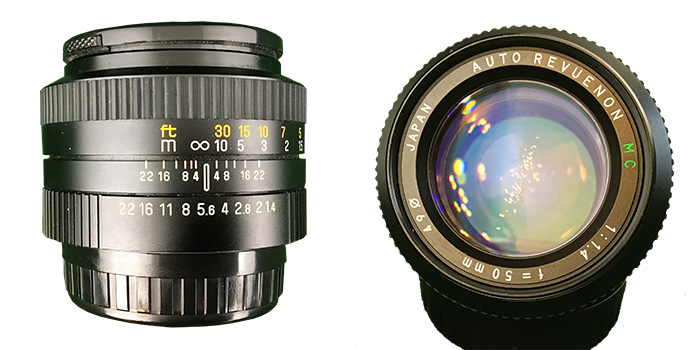
The tested sample (#C601883) has an 8-bladed aperture. The sample in question came to me in absolutely mint condition, and shows neither signs of use nor of neglect.
It is worth noting, that the lens (similarly to the Pentax-M) does not have the requisite apparatus to allow a Pentax K body to control the lens’ aperture (This is a Pentax K, not Pentax KA lens).
While not quite as tiny as the Pentax-M, nor as light as the Canon FDn, the Revuenon is by no means a big lens. Personally, I actually thought it was the smallest of the lot (until I measured them all) and I attribute this perception to the clean and decidedly minimalistic design of the lens. While (on visual inspection) it is quite obvious that the design of the lens barrel and interface does not originate within any of the big players’ design bureaus, the lens’ overall appearance is quite striking. This is not one of those off-brand lenses where you clearly see that little thought went into the lens’ aesthetics. Whether you find the somewhat clinical result to be to your liking is – however – another story.
Personally, I find the Revuenon handles both nicely, and hideously. Although the focus ring is decidedly narrow, the rubbering is quite grippy. As the focus ring also turns quite easily, the combination is more than workable. The aperture ring OTOH does not get good marks. Firstly, the aperture ring lacks any rubber, and the milled shallow ridges offer only slight friction. Secondly, as the motion of the aperture ring on top of that is quite raspy (I’d almost say Konica-esque), its operation is decidedly not liable to feel trustworthy. I found myself constantly (visually) checking the aperture I’d landed on, as counting the clicks felt error prone.
Read more (elsewhere):
• Lens review of the same Revuenon 50/1.4 version on Lichtsucher
• Lens review of the other Revuenon 50/1.4 version on Altglas-Container (in German)
• Several Reviews on Pentaxforums.com (unknown which versions)
Lens characteristics and handling – summary
The main specifications are summarised in the table below:
| name | f-max | f-min | mount | length/diam.-weight | design | filter mm | MFD (m) | focus throw | € @ eBay[1] |
|---|---|---|---|---|---|---|---|---|---|
| Canon FD | 1.4 | 16 | Canon FD | 52/67-368g | 7e / 6g / 8b | 55 | 0,45 | 210 | 60–100€ |
| Canon FDn | 1.4 | 22 | Canon FDn | 44/65-234g | 7e / 6g / 8b | 52 | 0,45 | 210 | 60-100€ |
| Carl Zeiss | 1.4 | 16 | C/Y | 42/64-273g | 7e / 6g / 6b | 55 | 0,45 | 210 | 200-300€[2] |
| Carl Zeiss Jena | 1.4 | 16 | Praktica B | 44/63-273g | 7e / 6g / 6b | 52 | 0,4 | 260 | 100–160€ |
| Konica | 1.4 | 22 | Konica AR | 46/63-271g | 7e / 6g / 8b | 55 | 0,45 | 210 | 50–80€ |
| Minolta 58 | 1.4 | 16 | Minolta SR | 43/67-322g | 6e / 5g / 8b | 55 | 0.6 | 280 | 60–100€ |
| Minolta 50 | 1.4 | 16 | Minolta SR | 47/63-303g | 7e / 5g / 6b | 55 | 0,5 | 170 | 60–90€ |
| Pentax-M | 1.4 | 22 | Pentax K | 38/63-236g | 7e / 6 g / 8b | 49 | 0,45 | 190 | 50–70€ |
| Revuenon | 1.4 | 22 | Pentax K | 41/62-259g | 6e / 5g / 8b | 49 | 0,45 | 210 | 40–60€ |
Notes:
[1] “eBay prices” reflect the cheaper (but not cheapest) end of the spectrum of recent completed sales (of items listed as in working condition) on eBay (without freight and customs). This is a price you can expect to buy the item at if you have patience to wait for a good deal. n.B! This may change quickly.
[2] Very popular among cine-modders (especially MM-version). Pristine copies fetch very high prices (>500 €/$)
Keeping in mind that all these lenses have similar defining characteristics (focal length & max aperture), the table shows very few variations, and most of those variations are really reflections on the era of a lens and the lens lineups in question. Thus one can quite clearly see the following trends:
• 7 elements in 6 groups really is the standard setup for a fast fifty (but there are exceptions).
• Older / earlier lenses minimum aperture tended towards f/16, whereas younger / newer lenses more usually offered f/22.
• Older lenses are heavier than newer lenses.
• An MFD of ≈0,45 meters is par for the course, and while some lenses land a bogey (the Minolta’s), the CZJ Prakticar lands a birdie (0,4 meters is very good for a fast fifty, but still clearly short of macro range)
• The filter thread diameters are in line with what was customary for each brand (Canon 55, later 52 mm; Konica 55 mm, Zeiss 55 mm, etc.)
Handling is a more complex issue – partially due to the difficulty in quantifying handling, partially due to the importance of taste in such a judgment. These opinions I’ve presented above (while discussing each lens) are therefore purely my own. Allow me, however, to offer some comparative comments.
One interesting aspect of these lenses is in the ‘way they turn’. While Nikon lenses are sometimes mentioned as a family/brand of lenses that reverse the common operating logic, in the world of legacy lenses, such issued can be even more complex, as is illustrated by the picture below:

This comparison exhibits three different logic’s:
• Largest aperture on right & MFD on right: Pentax-M, Revuenon;
• Largest aperture on left & MFD on left: Canon x2, Carl Zeiss, Konica, Minolta x2;
• Largest aperture on right & MFD on left: Carl Zeiss Jena
While I never mind when I switch from using one rotation direction to another – I somehow manage to take it in stride – I’m well aware that this is a potential dealbreaker for some.
It is glaringly obvious that some of these lenses’ aperture rings were not designed to be frequently used: While the Canon FD’s aperture ring is still very tactile, the same can no longer be said about the FDn. Sadly, the same applies also to the Hexanon and the Revuenon. In the case of the Canon FDn and Hexanon, this is understandable (which, however, does not make it any less awkward) as Hexanon AR’s and later Canon’s were designed with body-operated aperture control in mind. In the case of the Revuenon this excuse does not apply. In the case of all three lenses, using the aperture control ring feels slightly like removing callus with a cheese grater: raspy, potentially painful, and like something you should stop doing.
The second interesting aspect is in the f-stop clicks these lenses’ aperture rings offer. The table below summarises the click-stops offered by the lenses in this comparison.
| Lens/f-stop | 1.4 | 1.7/ 1.8 | 2 | 2.4 | 2.8 | 3.3 | 4 | 4.8 | 5.6 | 6.8 | 8 | 9.5 | 11 | 13 | 16 | 19 | 22 |
|---|---|---|---|---|---|---|---|---|---|---|---|---|---|---|---|---|---|
| Canon FD | X | X | X | X | X | X | X | X | X | X | X | X | X | X | X | – | – |
| Canon FDn | X | X | X | X | X | X | X | X | X | X | X | X | X | X | X | X | X |
| Carl Zeiss | X | O | X | O | X | O | X | O | X | O | X | O | X | O | X | – | – |
| Carl Zeiss Jena | X | X | X | X | X | X | X | X | X | X | X | X | X | X | X | – | – |
| Konica | X | O | X | O | X | O | X | O | X | O | X | O | X | O | X | O | X |
| Minolta 58 | X | O | X | O | X | O | X | O | X | O | X | O | X | O | X | – | – |
| Minolta 50 | X | O | X | X | X | X | X | X | X | X | X | X | X | X | X | – | – |
| Pentax-M | X | O | X | X | X | X | X | X | X | X | X | X | X | X | X | O | X |
| Revuenon | X | O | X | X | X | X | X | X | X | X | X | X | X | X | X | O | X |
0 lacks click stop
– not in offered range
Considering that all lenses tend to be soft wide open and that they often sharpen up nicely with even a small closing down, not offering intermediate click stops at the open end is something I will never understand. For lenses that categorically only offer full stops (Carl Zeiss, Konica, Minolta 58), not offering a click stop at f/1.7 is fully understandable, but why the Minolta 50, Pentax-M and Revuenon start offering half stops only once they’ve reached f/2, I will never know.
Thirdly, and finally, regarding lenses of those systems that were (in their day and age) predominantly geared toward shutter priority (and, later, program auto) have an “Auto exposure” mode: With Konica lenses, this feature is (for modern use as adapted lenses) most annoying, as the auto exposure mode is “just one more click” past minimum aperture, with the difference that this click locks, and you need to press a button to make the aperture ring usable again. While also Canon implemented a separate auto mode on FD and FDn lenses, the auto setting did either not lock (early FD) or could not be engaged/disengaged without simultaneously pressing a button and rotating the aperture ring.
In sum, even though you may feel that the primary purpose of a lens is to render a picture on your film/sensor, once you get around to actually using lenses, you will start to appreciate handling and ergonomics.
Next…?
• Part 1: Introduction, the lenses: pedigree and handling (you are here)
• Part 2: IQ-comparison I – The Brick wall test
• Part 3: IQ comparison II – Urban vistas
• Part 4: IQ-comparison III – Bokeh and blur
• Part 5: IQ-comparison IV – Night-time vistas
• Part 6: Summary and conclusions
Footnotes
1 There seems to have been some overlap around 1982, as I’ve heard/read reports of (cosmetically) first versions that do not excite a geiger counter, as well as second versions that are radioactive.